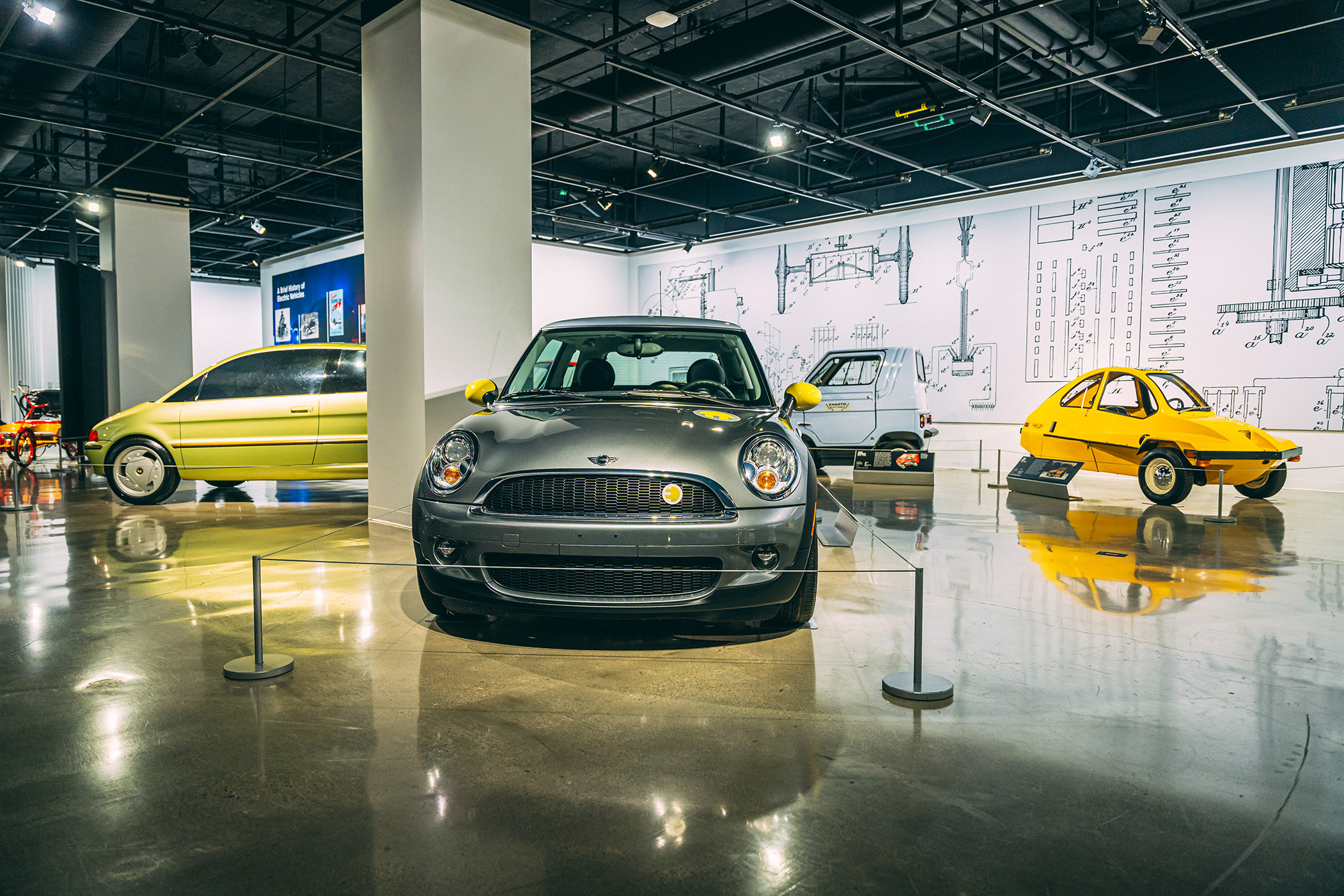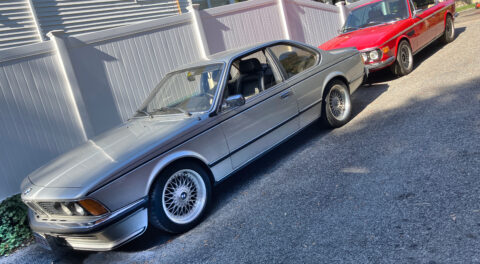BMW has been a major player and innovator in the electric-vehicle market, from early test vehicles to the imagination-capturing BMW i8 and i3 production models. And now, BMW’s pioneering engineering and innovations that helped make electric-vehicles a truly viable and attractive options are being celebrated as part of the “Alternating Currents: The Fall and Rise of Electric Vehicles” exhibit at the Petersen Automotive Museum in Los Angeles, California.

Read the full press release below:
Woodcliff Lake, NJ – September 20th, 2024…The BMW Group’s pioneering electromobility innovation history is highlighted as part of a new exhibit at the Petersen Automotive Museum in Los Angeles, California. Titled: “Alternating Currents: The Fall and Rise of Electric Vehicles”, the exhibit showcases the progression of electric vehicle developement from the late 1800s to modern concepts. Located in the Propulsion Gallery on the second floor, “Alternating Currents” traces the evolution of electric vehicle production and usage from the early days to the modern resurgence and future advancements. BMW specifically is showcasing some early electromobility development work with the 1992 BMW E2 Concept and well as the road to innovative and sustainable high volume electric models with the 2009 MINI E, 2009 BMW Vision Efficient Dynamics and the 2013 BMW i3.
Based on the development groundwork of these important BMW historical models, the BMW Group today boasts a portfolio of seventeen Battery Electric Vehicle (BEV) models in the U.S.A. across all the Group brands (BMW, MINI, Rolls-Royce Motorcars and BMW Motorrad). Battery Electric Vehicles currently account for over 15% of BMW Group’s U.S. annual sales. Furthermore, BMW is preparing the launch of its next generation BEVs known as the Neue Klasse vehicles starting in 2025.
A video overview of each featured BMW Group models is available at:
https://youtu.be/wrNAQuOZLKE?si=vX0odX586zfeuA3e
A video description of the philosophy behind the Neue Klasse is available at:
https://youtu.be/nSrUbM_vTyA?si=qIBgABWrgUBMoLcV
The Alternating Currents exhibit runs from August 2024 through June of 2025.
The BMW E2 Electric Vehicle Concept returns to California for the first time since 1991.
Designed in the early 1990’s the BMW E1 and E2 electric concepts were innovative yet mainstream looking vehicles that illustrated BMW electric vehicle aspirations at the time. The initial model, the BMW E1, was designed in Germany by BMW Technik GmbH and powered by a 45 hp, brushless DC motor mounted at the rear axle. The battery technology at the time was sodium-sulfur and two fully functional E1 prototypes were used as a testbed for early electromobility technology development.
The second, larger iteration named the BMW E2 was penned by California-based Designworks/USA (now a fully owned subsidiary of BMW AG) and shown at the 1991 Los Angeles International Auto Show. According to Designworks/USA founder and president at the time, Chuck Pelly, the studio’s intent was to give the E2 a formidable stance, with strong wheel flares and tires moved outboard as much as possible. A more substantial hood and bumper system were also integrated. “It’s a totally new body,” added Pelly, “that’s more traditionally BMW styled, with less reversals” than the original E1. It’s also longer, wider, and lower with a smoother overall shape.
Inside the E2 was seating for four with storage behind the rear seat. A rounded dash integrated driver and passenger airbags and a speedometer, range indicator, and clock. Forward/reverse controls and an electric handbrake were also provided.
Sadly, the E1 and E2 projects were abandoned by the mid 1990’s but both cars remain as early studies of how “The Ultimate Driving Machine” and electromobility could be combined.
MINI E: The Testbed for the Modern Era of Electrification

It would take another 17 years before electric motor and battery technology would progress to the point where the BMW Group felt that it was time to ramp up it’s electromobility development. The 2009 MINI E was the initial product offering and starting the first quarter of 2009, the MINI E became available to select private and corporate customers as part of a 450 vehicle, U.S. field trial in California, New York and New Jersey. Fifty additional vehicles were deployed in Europe for a total of 500. The successful applicants were selected based on the mileage and type of driving they expected to do, how suitable their residences were for installation of a charging system and whether they agreed to provide continual feedback to the BMW Group.
The MINI E provided the agility and handling of the contemporary MINI Cooper yet was powered by a 204 horsepower asynchronous electric motor fed by a high-performance 35kwh lithium-ion battery capable of approximately 150 miles of range. Since the back-seat space was needed for the lithium-ion battery, the MINI E was a two-seater car. Power was transferred to the front wheels via a single-stage helical gearbox nearly silently and entirely emissions free. The powertrain was a collaboration between BMW Group and AC Propulsion Systems of California.
The MINI E’s electric drivetrain produced seamless acceleration to 62 mph in 8.5 seconds. Top speed was electronically limited to 95 mph. With a suspension designed particularly for the MINI E and an even weight distribution, the MINI E offered the spirited driving pleasure of a true MINI.
The MINI E field trial proved to be invaluable to the development work being done by the BMW Group’s Project i on what was called a Mega-City Vehicle – the company’s innovative program to develop a volume vehicle solution to the demands of the world’s largest cities in the 21st century. This development ultimately culminated in the 2013 BMW i3.
At the end of the U.S. and European field trials, all 500 MINI E were returned to BMW Group and most were recycled. Only a few examples still exist. Many of the initial MINI E field trail customers, known within their ranks as “electronauts” went onto to the BMW Active E field trial program and ultimately purchased BMW i3s.
BMW i3. The First Volume Production CFRP Automobile.

The all-electric 2013 BMW i3 was a landmark in BMW’s mission to provide a completely sustainable, electric vehicle that stayed true to the Ultimate Driving Machine tag line. The BMW i3 was the first product of the new BMW i sub-brand and was truly a purpose-built electric car that heralded a new era of electromobility at BMW.
The vehicle concept behind the BMW i3 was designed from the outset to incorporate an all-electric drive system. This had numerous advantages over “conversion” vehicles (such as the MINI E and subsequent BMW Active E), in which the original combustion engine and fuel tank is swapped for an electric motor and battery pack. The engineers could design whatever worked best, in terms of construction, dimensions and configuration of the electric drive system’s components. This led to the “LifeDrive” architecture concept, which was purpose-built specifically for the BMW i3. It was comprised of two modules: The Life Module, and the Drive Module. Think of the Life Module as the passenger cabin. It was the first-ever mass-produced Carbon Fiber Reinforced Plastic (CFRP) passenger cell in the automotive industry and was a big factor in the cars efficiency. Carbon Fiber Reinforced Plastic is equally as strong as steel, while being 50% lighter. The result was an electric car that weighed only about 2,700 lbs.
Due to the lightweight, high tensile strength of CFRP, the passenger cell had added protection, and the battery had less work to do, which allowed for the use of a smaller, lighter battery that saved even more weight, reducing charging time and increasing range. The lightweight design of the Life Module also lowered the BMW i3’s center of gravity, making it a more engaging and dynamic to drive.
The Drive Module, which was constructed out of 100% aluminum, consisted of the 22-kWh, 450 lb. lithium-ion battery, the in-house developed and produced electric motor, MacPherson strut and 5-link rear suspension system and structural/crash systems.
Another benefit of the LifeDrive architecture concept was that there was no space-consuming transmission tunnel running through the center of the car, like in most internal combustion powered cars, because of the separate Drive Module. This gave the BMW i3 the interior space of the BMW 3 Series, while only having the footprint of the much smaller BMW 1 Series.
To illustrate the innovative LifeDrive architecture, the i3 on display has been deconstructed to showcase both the CFRP Life Module and the Aluminum Drive Module.
The BMW Vision Efficient Dynamics.
Technology and Design so Compelling it had to Produced.

The BMW Vision EfficientDynamics was presented for the first time at the 2009 IAA Frankfurt Motor Show. The BMW Vision EfficientDynamics was conceived as a “clean-sheet” design study to illustrate that efficiency, driving pleasure, technology, and emotional design could all be integrated in one stunning vehicle. The powertrain provided a top speed limited electronically to 155 mph, with acceleration to 62 mph in 4.8 seconds. Average fuel consumption was estimated at 62.6 mpg.
The power and performance were made possible by combining a fuel-efficient 3-cylinder turbo-diesel combustion engine with one electric motor on each axle. The intelligent combination of these units, together with precisely controlled energy management, simultaneously enhanced the dynamic performance and the efficiency of the car. Overall system output was listed at 356 horsepower, and peak torque was 590 lb-ft. The combination of the two electric motors and the diesel engine allowed all-wheel drive when driving in all-electric mode. The result was minimum power loss and a harmonious transmission of the power available under all conditions.
In its design, BMW Vision EfficientDynamics differed from the usual low-emission car concepts. The principle of “form follows function” was not just employed for the overall look of the car, but embraced in each and every detail. Measuring 48.8″ in height and boasting a sweeping, arch-like roofline, BMW Vision EfficientDynamics offered the slender silhouette of a classic GT car. With the combustion engine fitted transversally in front of the rear axle, the designers succeeded in giving the car a very low front end, with the flow of air being further smoothened by active louvers in front of the radiator, which would close completely when the need for cooling air was low. This efficient function followed in the footsteps of the active air flap control already a feature of BMW EfficientDynamics in some of BMW’s concurrent production models.
Numerous details in the design of the body were based on the know-how BMW had gained in Motorsport with a number of body elements serving as air deflectors and guide vanes. Designed as ducts, for example, the A-pillars served to channel the flow of air in the same way as the rear lights with their wing profile. The floor of the car was fully flat from front to rear and from side to side, thus maintaining a smooth surface to avoid any air swirl liable to increase fuel consumption. Slender openings around the front air dam guided the air flowing specifically into two ducts leading through the front air dam to the wheel arches where the air comes out again through a very slim aperture at high speed, flowing just next to the outer wheel flanks. This air jet rested on the front wheels like a curtain and was therefore referred to most appropriately as the “air curtain.” It provided a highly stabilizing effect.
The extra-large wheel covers extending over part of the tire sidewalls added to the unique look of BMW Vision EfficientDynamics from the side. The blade profile integrated in the wheels served to further reduce the negative effect of the turning wheels on the overall aerodynamics of the car. In all, these features optimized the aerodynamic qualities of the car give the BMW Vision EfficientDynamics concept car a very low drag factor (CX) of just 0.22.
The Vision Efficient Dynamics was so compelling on the auto show circuit in 2009 and 2010 that feasibility plans were quickly developed to see if the car could be brought into production. The result was the introduction of the 2014 BMW i8 that incorporated much of the drivetrain innovation as well a very faithful conversion of the design to production.

Read the full press release here.
Tags: electric electromobility i3 i8 innovation mini























